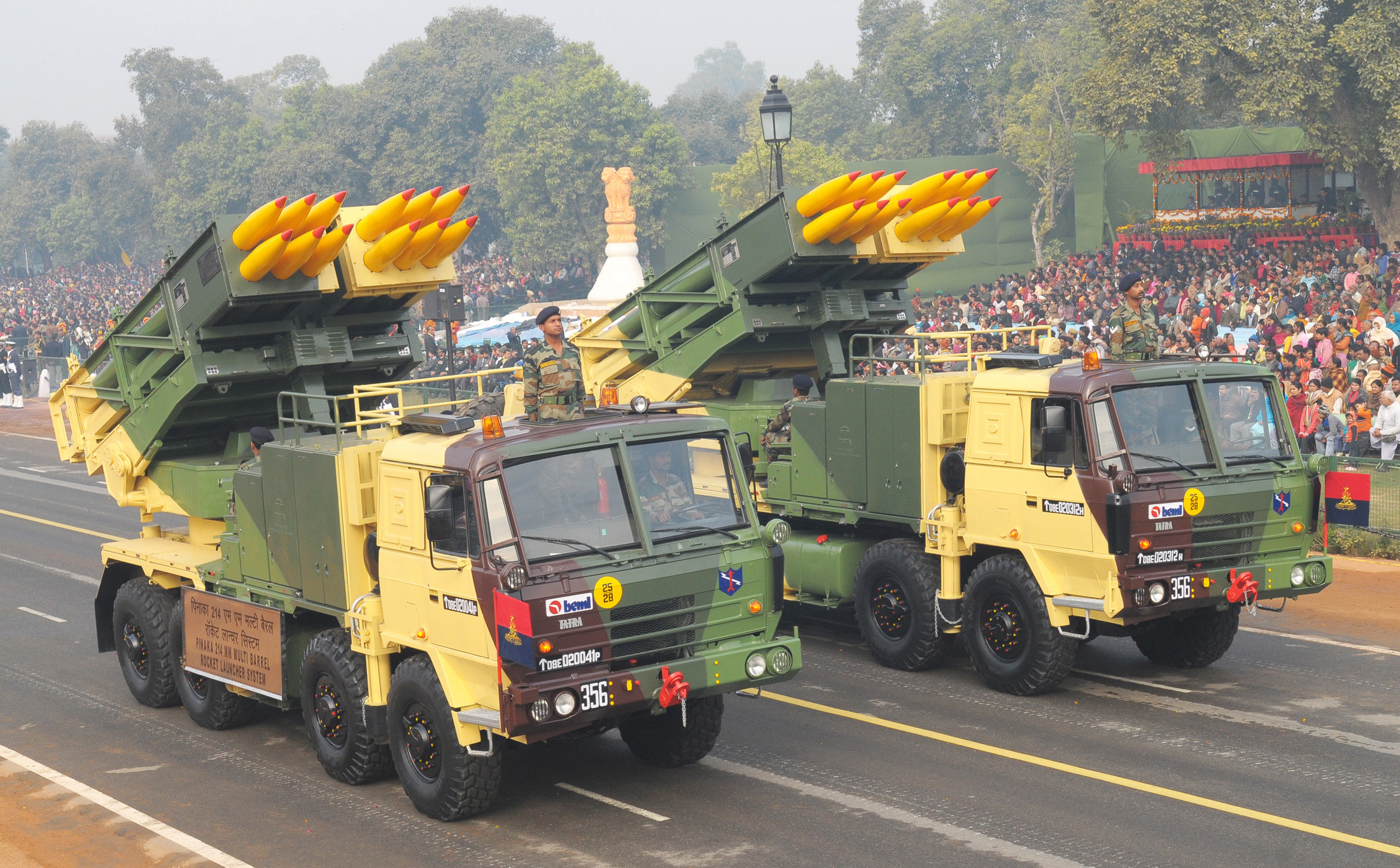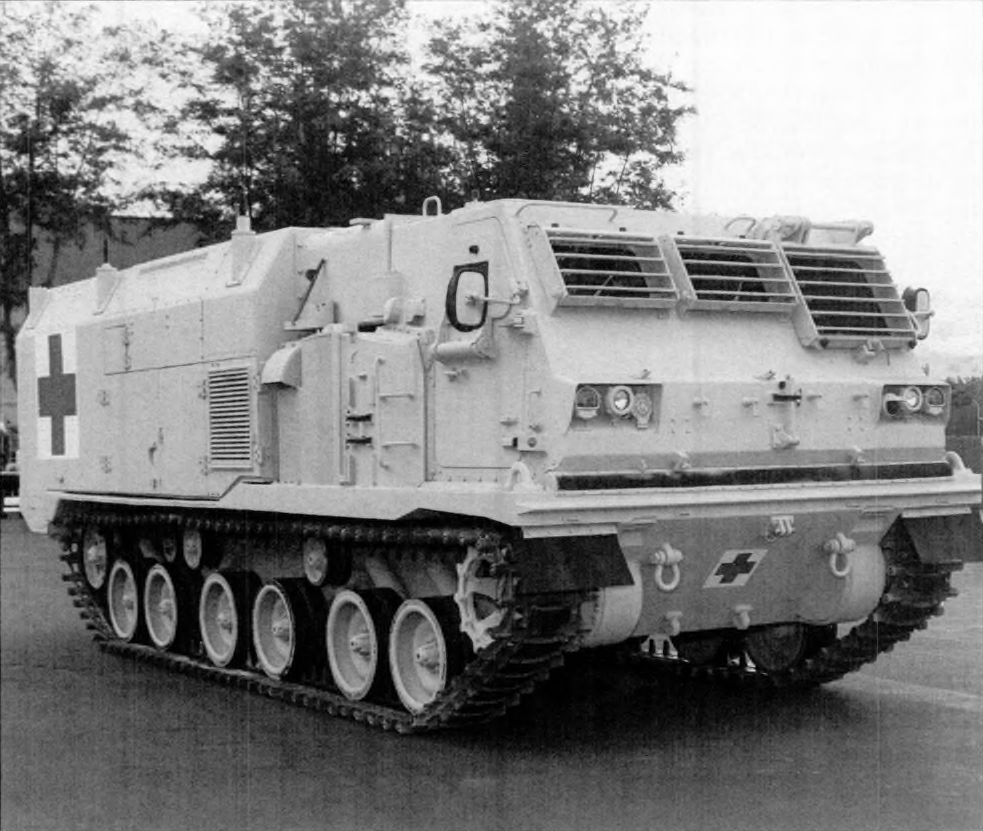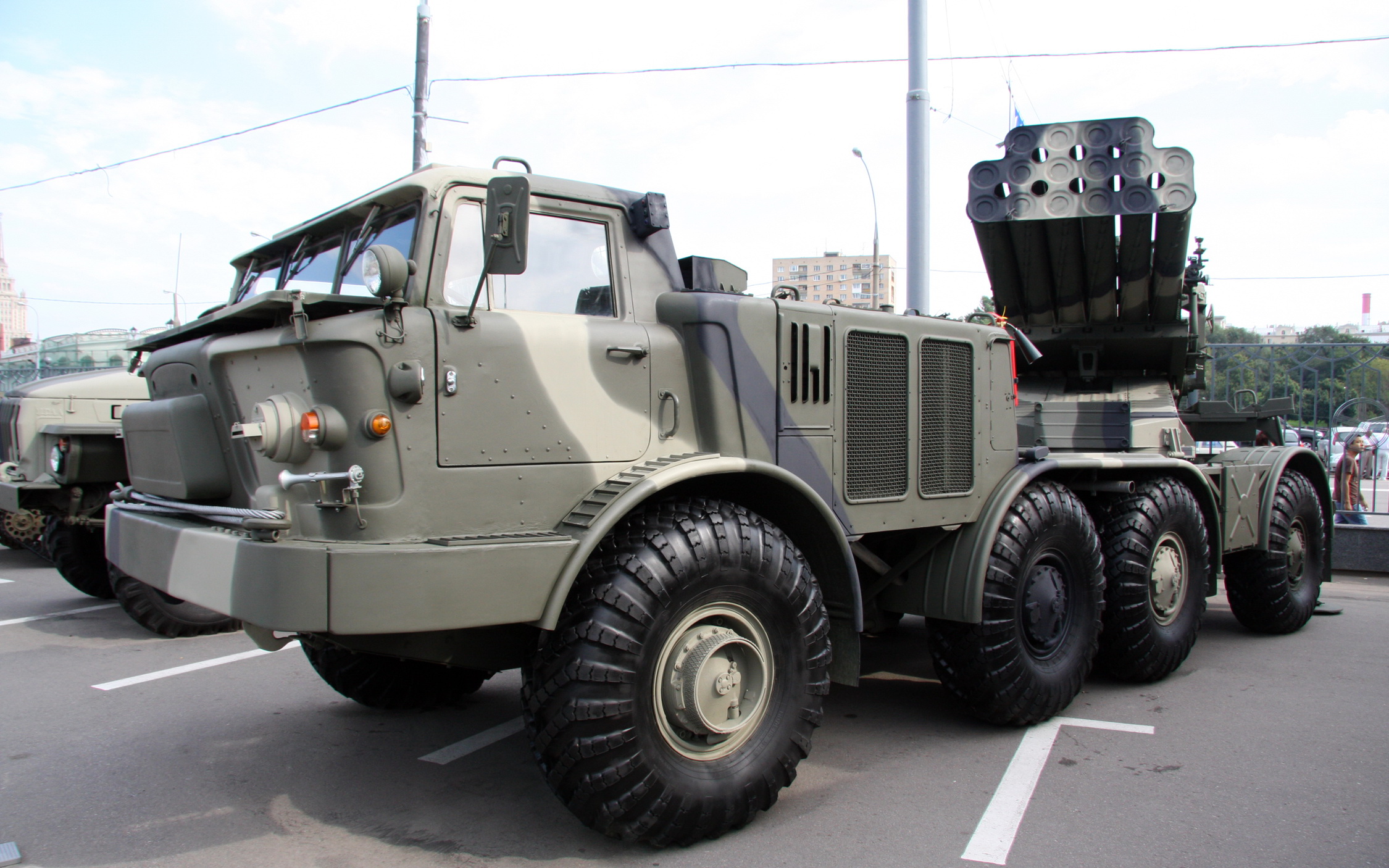|
Polonez (multiple Rocket Launcher)
The Polonez is a Belarusian 300 mm rocket artillery system of a launcher unit comprising eight rockets packaged in two four-rocket pods mounted on a MZKT-7930 vehicle. In 2018, it was exported to Azerbaijan. The system was designed by the Belarusian Plant of Precision Electromechanics in cooperation with a foreign country, probably China. The first combat missile launches were carried out in China. The 77th Separate Rocket Artillery Battalion of the 336th Rocket Artillery Brigade of the Belarusian Ground Forces is equipped with it. An upgraded version called Polonez-M passed all trials and has been accepted into service by the Belarusian Ground Forces as of May 2019. Polonez-M has an increased range of 290 km (186.4 mi), a higher share of domestic components and can fire the improved A-300 missile. See also * Katyusha, BM-13, BM-8, and BM-31 multiple rocket launchers of World War II * T-122 Sakarya, Turkish 122 mm multiple launch rocket system * Fajr-5, Iranian 333 mm long-r ... [...More Info...] [...Related Items...] OR: [Wikipedia] [Google] [Baidu] |
Multiple Rocket Launcher
A multiple rocket launcher (MRL) or multiple launch rocket system (MLRS) is a type of rocket artillery system that contains multiple launchers which are fixed to a single platform, and shoots its rocket ordnance in a fashion similar to a volley gun. Rockets are self-propelled in flight and have different capabilities than conventional artillery shells, such as longer effective range, lower recoil, typically considerably higher payload than a similarly sized gun artillery platform, or even carrying multiple warheads. Unguided rocket artillery is notoriously inaccurate and slow to reload compared to gun artillery. A multiple rocket launcher helps compensate for this with its ability to launch multiple rockets in rapid succession, which, coupled with the large kill zone of each warhead, can easily deliver saturation fire over a target area. However, modern rockets can use GPS or inertial guidance to combine the advantages of rockets with the higher accuracy of precision-guided mu ... [...More Info...] [...Related Items...] OR: [Wikipedia] [Google] [Baidu] |
TOROS Artillery Rocket System
TOROS artillery rocket system ( tr, Topçu Roket Sistemi; , lit. " Gunner") is a Turkish rocket artillery multiple rocket launcher system that has been developed in both 230 and 260 mm calibre. The system was developed by TÜBİTAK-SAGE, and is used by the Turkish Army. The larger calibre rockets have a maximum range of deliver a high-explosive fragmentation warhead containing 30,000 steel balls. It is developed by the Turkish Defense Industry. Description This system is in general copy of Military Technical Institute Belgrade M-87 Orkan with some minor modification in rocket design, different fuel for rocket and tubes. It is developed through reverse engineering and plans obtained for Orkan M-87 including launcher M-87 and rocket 262mm used in that process all obtained from BNT Bratstvo Novi Travnik from Bosnia and Herzegovina. Sage is also known for reverse engendering of M270 Multiple Launch Rocket System 227mm rocket under designation SAGE 227 a program started becau ... [...More Info...] [...Related Items...] OR: [Wikipedia] [Google] [Baidu] |
Modular Rocket Launchers
Broadly speaking, modularity is the degree to which a system's components may be separated and recombined, often with the benefit of flexibility and variety in use. The concept of modularity is used primarily to reduce complexity by breaking a system into varying degrees of interdependence and independence across and "hide the complexity of each part behind an abstraction and interface". However, the concept of modularity can be extended to multiple disciplines, each with their own nuances. Despite these nuances, consistent themes concerning modular systems can be identified. Contextual nuances The meaning of the word "modularity" can vary somewhat based on context. The following are contextual examples of modularity across several fields of science, technology, industry, and culture: Science *In biology, modularity recognizes that organisms or metabolic pathways are composed of modules. *In ecology, modularity is considered a key factor—along with diversity and feedback—in ... [...More Info...] [...Related Items...] OR: [Wikipedia] [Google] [Baidu] |
Multiple Rocket Launchers
A multiple rocket launcher (MRL) or multiple launch rocket system (MLRS) is a type of rocket artillery system that contains multiple launchers which are fixed to a single platform, and shoots its rocket ordnance in a fashion similar to a volley gun. Rockets are self-propelled in flight and have different capabilities than conventional artillery shells, such as longer effective range, lower recoil, typically considerably higher payload than a similarly sized gun artillery platform, or even carrying multiple warheads. Unguided rocket artillery is notoriously inaccurate and slow to reload compared to gun artillery. A multiple rocket launcher helps compensate for this with its ability to launch multiple rockets in rapid succession, which, coupled with the large kill zone of each warhead, can easily deliver saturation fire over a target area. However, modern rockets can use GPS or inertial guidance to combine the advantages of rockets with the higher accuracy of precision-guided mu ... [...More Info...] [...Related Items...] OR: [Wikipedia] [Google] [Baidu] |
Self-propelled Artillery Of Belarus
Self-propelled may refer to * Human-powered transport, humans moving themselves (and their cargo) via their own muscle energy * Machines that power their own movement: ** Automobile (from ''auto-'' + ''mobile'', "self-moving") ** Locomotive (from ''loco-'' + ''motive'', "moving from its current place") ** Multiple units, self-propelled train carriages ** Self-propelled artillery *** Self-propelled gun *** Self-propelled anti-aircraft weapon *** Tank destroyer, a self-propelled anti-tank gun *** Mortar carrier, a self-propelled mortar ** Self-propelled modular transporter ** Leonardo's self-propelled cart ** Self-propelled barge T-36 The self-propelled barge T-36 was a Soviet barge of the Project 306 type. Its waterline length is 17.3 m, width is 3.6 m, depth is 2 m, draft is 1.2 m. Tonnage is 100 tons, barge has two engines, speed is 9 knots. The barge is known for drifting ... * Self-propelled particles, a model for studying the motion of swarms {{Disambiguation ... [...More Info...] [...Related Items...] OR: [Wikipedia] [Google] [Baidu] |
Wheeled Self-propelled Rocket Launchers
A wheel is a circular component that is intended to rotate on an axle bearing. The wheel is one of the key components of the wheel and axle which is one of the six simple machines. Wheels, in conjunction with axles, allow heavy objects to be moved easily facilitating movement or transportation while supporting a load, or performing labor in machines. Wheels are also used for other purposes, such as a ship's wheel, steering wheel, potter's wheel, and flywheel. Common examples are found in transport applications. A wheel reduces friction by facilitating motion by rolling together with the use of axles. In order for wheels to rotate, a moment needs to be applied to the wheel about its axis, either by way of gravity or by the application of another external force or torque. Using the wheel, Sumerians invented a device that spins clay as a potter shapes it into the desired object. Terminology The English word ''wheel'' comes from the Old English word , from Proto-Germanic , from ... [...More Info...] [...Related Items...] OR: [Wikipedia] [Google] [Baidu] |
TOS-1
TOS-1 (russian: тяжёлая огнемётная система �ОС-1}, Heavy Flamethrower System) is a Soviet 220 mm 30-barrel (original system, Object 634 or TOS-1M) or 24-barrel (Object 634B or TOS-1A) multiple rocket launcher capable of using thermobaric warheads, mounted on a T-72 tank chassis. TOS-1 was designed to attack enemy fortified positions and lightly armoured vehicles and transports, in open terrain in particular. First combat tests took place in 1988 and 1989 in the Panjshir Valley during the Soviet–Afghan War. The TOS-1 was shown for the first time in public in 1999 in Omsk. TOS-1 is not assigned to the artillery units of the Russian Armed Forces but is found in Russian NBC Protection Troops. Development The idea of a heavy short-range MLRS to launch rockets equipped with incendiary and thermobaric warheads arose in the late 1970s. The combat system consisting of the combat vehicle, rockets, and loading vehicle was developed in early 1980s at KBTM ... [...More Info...] [...Related Items...] OR: [Wikipedia] [Google] [Baidu] |
Pinaka Multi Barrel Rocket Launcher
Pinaka (from Sanskrit: पिनाक, see Pinaka) is a multiple rocket launcher produced in India and developed by the Defence Research and Development Organisation (DRDO) for the Indian Army. The system has a maximum range of 40 km for Mark-I and 60 km for Mark-I enhanced version, and can fire a salvo of 12 HE rockets in 44 seconds. The system is mounted on a Tatra truck for mobility. Pinaka saw service during the Kargil War, where it was successful in neutralising Pakistani positions on the mountain tops. It has since been inducted into the Indian Army in large numbers. As of 2014, about 5,000 missiles are being produced every year while an advanced variant is under development with enhanced range and accuracy. As of 2019, an upgraded guided missile version of the system has been test-fired, with a range of over 90 km. Development The Indian Army operates the Russian BM-21 Grad Launchers. In 1981, in response to the Indian Army's need for a long rang ... [...More Info...] [...Related Items...] OR: [Wikipedia] [Google] [Baidu] |
M270 Multiple Launch Rocket System
The M270 Multiple Launch Rocket System (M270 MLRS) is an American-developed armored, self-propelled, multiple rocket launcher. The U.S. Army variant of the MLRS vehicle is based on the chassis of the Bradley Fighting Vehicle. The first M270s were delivered in 1983. The MLRS were subsequently adopted by several NATO countries and other countries. The MLRS first saw service with the United States in the 1991 Gulf War. The MLRS has been upgraded to fire guided missiles, and has been used by Ukraine in the 2022 Russian invasion of Ukraine. Description Background In the early 1970s, the Soviet Union had a clear advantage over U.S. and NATO forces in terms of rocket artillery. Soviet tactics of bombardment by large numbers of truck-mounted multiple rocket launchers (MRLs), such as the BM-21, would saturate a target area with thousands of rockets, ensuring some would hit specific targets while delivering a psychological impact. By contrast, U.S. artillerists favored cannon artiller ... [...More Info...] [...Related Items...] OR: [Wikipedia] [Google] [Baidu] |
BM-27 Uragan
The BM-27 Uragan (russian: БМ-27 Ураган, lit=Hurricane; GRAU index 9P140) is a self-propelled 220 mm multiple rocket launcher designed in the Soviet Union. The system began its service with the Soviet Army in the late 1970s, and was its first modern spin and fin stabilized heavy multiple rocket launcher. Description The BM-27 Uragan is capable of launching 220 mm rockets from 16 launch tubes mounted on the rear of a ZIL-135 8×8 chassis. This vehicle is extremely similar to that used in the FROG-7 free flight rocket system. It has two gasoline engines that power its 20 tonnes to a maximum speed of 65 kilometers per hour. One engine drives the four wheels on the left of the truck, while the other engine drives the four wheels on the right. The ZIL-135 has eight wheel drive, but only the front and rear axles are used for steering. It has a maximum cruising range of 500 kilometers. The cab of the ZIL-135 is NBC protected, allowing the rockets to be fired without ... [...More Info...] [...Related Items...] OR: [Wikipedia] [Google] [Baidu] |
BM-21 Grad
The BM-21 "Grad" (russian: БМ-21 "Град", lit= hail) is a self-propelled 122 mm multiple rocket launcher designed in the Soviet Union. The system and the M-21OF rocket were first developed in the early 1960s, and saw their first combat use in March 1969 during the Sino-Soviet border conflict. ''BM'' stands for ''boyevaya mashina'' ( ru , боевая машина – combat vehicle), and the nickname means "hail". The complete system with the BM-21 launch vehicle and the M-21OF rocket is designated as the M-21 field-rocket system. The complete system is more commonly known as a Grad multiple rocket launcher system. In NATO countries the system, either the complete system or the launch vehicle only, was initially known as the M1964. Several other countries have copied the Grad or have developed similar systems. In Russian service its intended replacement is the 9A52-4 Tornado. Many similar 122 mm MLRS systems are made by different countries based on the BM-21 Grad. ... [...More Info...] [...Related Items...] OR: [Wikipedia] [Google] [Baidu] |
BM-14
The BM-14 (BM for ''Boyevaya Mashina'', 'combat vehicle'), is a Soviet-made 140mm multiple launch rocket system (MLRS), normally mounted on a truck. The BM-14 can fire 140 mm M-14 rockets with a high-explosive fragmentation warhead, a smoke warhead or a chemical warhead. It is similar to the BM-13 "Katyusha" and was partly replaced in service by the 122 mm BM-21 Grad. Launchers were built in 16 and 17-round variants. The rockets have a maximum range of . The weapon is not accurate as there is no guidance system, but it is extremely effective in saturation fire. Variants * BM-14 (8U32) - 16-round model (two rows of 8), launcher mounted on the ZIS-151 truck. Entered service in 1952. Also known as BM-14-16. ** BM-14M (2B2) - modified model, mounted on the ZIL-157. ** BM-14MM (2B2R) - final upgrade, mounted on the ZIL-131. * BM-14-17 (8U35) - 17-round (8+9 launch tubes) launcher, mounted on the GAZ-63A. Developed in 1959. This launcher was also used on naval vessels, for exampl ... [...More Info...] [...Related Items...] OR: [Wikipedia] [Google] [Baidu] |






